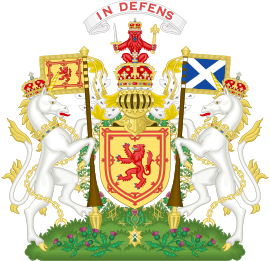Bishops' Wars
The 1639 and 1640 Bishops' Wars were the first of the conflicts known collectively as the 1638 to 1651 Wars of the Three Kingdoms, which took place in Scotland, England and Ireland. Others include the Irish Confederate Wars, the First, Second and Third English Civil Wars, and the Cromwellian conquest of Ireland.
| Bishops' Wars | |||||||
|---|---|---|---|---|---|---|---|
| Part of the Wars of the Three Kingdoms | |||||||
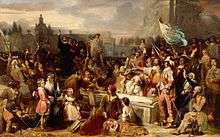 Signing of the National Covenant in Greyfriars Kirkyard, Edinburgh | |||||||
| |||||||
| Belligerents | |||||||
|
| |||||||
| Commanders and leaders | |||||||
| |||||||
| Strength | |||||||
| 20,000 - 25,000 | 20,000 | ||||||
| Casualties and losses | |||||||
| 300 - 400 | 300 - 600 | ||||||
Their origin stemmed from disputes over governance of the Church or Kirk of Scotland, dating back to the 1580s. Most Scots supported a Presbyterian kirk, in which they were not to be ruled by bishops appointed by the authority of the king, but rather were to be ruled by presbyters, ordained to the office by others of that kind[1] and inducted to a congregation after an election by members.[2] In the 17th century, debates over religious practice and structure were closely linked to different views of power and control; as a result, the conflict led to major changes to the Scottish political system, as well as the kirk.
Matters came to a head in 1637, when Charles I attempted to impose uniform practices on the kirk and the Church of England, changes also opposed by English Puritans. The 1638 National Covenant pledged to oppose such 'innovations', and in December, the General Assembly of the Church of Scotland voted to expel bishops from the kirk. This were followed in August 1639 by a series of acts passed by the Parliament of Scotland that amounted to a constitutional revolution
The Covenanters defeated attempts by Charles to re-impose his authority in 1639 and 1640, and gained control of Scotland, but to protect that settlement, they sought support from sympathisers in Ulster and England. Since Charles did the same, the result was to destabilise not only Scotland, but England and Ireland as well, ending in the Wars of the Three Kingdoms.
Background
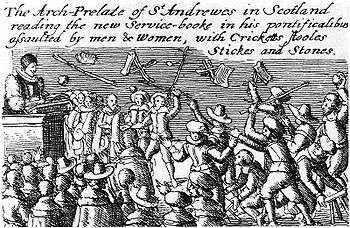
The Protestant Reformation created a Church of Scotland, or 'kirk', Presbyterian in structure, and Calvinist in doctrine. While 'Presbyterian' and 'Episcopalian' now implies differences in both governance and doctrine, this was not the case in the 17th century. Episcopalian structures were governed by bishops, usually appointed by the monarch, while Presbyterian implied rule by Elders, nominated by their congregations. Arguments over the role of bishops were as much about politics and the power of the monarch as religious practice.[3]
The vast majority of Scots, whether Covenanter or Royalist, believed a 'well-ordered' monarchy was divinely mandated; they disagreed on what 'well-ordered' meant, and who held ultimate authority in clerical affairs. Royalists generally emphasised the role of the monarch more than Covenanters, but there were many factors, including nationalist allegiance to the kirk, and individual motives were very complex. Montrose fought for the Covenant in 1639 and 1640, then became a Royalist, and switching sides was common throughout the period.[4]
When James VI and I succeeded as king of England in 1603, he viewed a unified Church of Scotland and England as the first step in creating a centralised, Unionist state.[5] However, although both were nominally Episcopalian in structure, the two churches were very different in doctrine, and even Scottish bishops objected to many Church of England practices.[6]
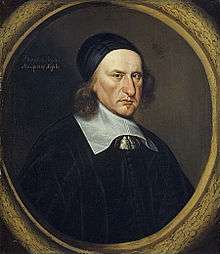
By the 1620s, Catholicism in Scotland was confined to parts of the aristocracy and the remote Highlands and Islands, but fear of 'Popery' remained widespread.[7] This was due to a general perception Protestant Europe was under attack. Scotland had close economic and cultural links with the Dutch Republic, then fighting for independence from Catholic Spain, while many Scots fought in the Thirty Years' War, a religious conflict that remains one of the most destructive conflicts in human history.[8]
The result was an increased sensitivity to changes in church practice; in 1636, a new Book of Canons replaced John Knox's Book of Discipline and excommunicated anyone who denied the King's supremacy in church matters.[9] When followed in 1637 by a new Book of Common Prayer, the result was anger and widespread rioting, said to have been set off with the throwing of a stool by Jenny Geddes during a service in St Giles Cathedral.[10]
In February 1638, representatives from all sections of Scottish society agreed a National Covenant, pledging resistance to liturgical 'innovations.'[11] Support for the Covenant was widespread except in Aberdeenshire and Banff, heartland of Royalist and Episcopalian resistance for the next 60 years.[12] The Marquess of Argyll and six other members of the Scottish Privy Council backed the Covenant.[13]
Charles agreed to defer discussion of the new canons to the General Assembly of the Church of Scotland, but made it clear to his supporters he had no intention of making any concessions. Aware of this, when the Assembly gathered in Glasgow in December it rejected the changes, expelled bishops from the kirk, and affirmed its right to meet annually, not just when the king agreed. The Marquis of Hamilton advised Charles there was now no alternative to war.[14]
1639; First Bishops' War

Charles decided to re-assert his authority by force, but preferred to rely on his own financial resources, rather than recalling Parliament. An English army of 20,000 would advance on Edinburgh from the south, while an amphibious force of 5,000 under the Marquis of Hamilton landed in Aberdeen, where it would link up with Royalist troops led by the Marquess of Huntly. Lastly, an Irish army under the Earl of Antrim would invade western Scotland from Carrickfergus, where he would join forces with the MacDonalds and other Royalist clans.[15]
The plan was overly complex, and preparations were hampered by lack of funds, while many Englishmen were sympathetic to the Covenanter cause. The Scots quickly occupied Dumbarton, preventing any prospect of an Irish landing, while Montrose occupied Aberdeen in March, leaving Hamilton unable to disembark his troops. In April, Royalist leader Lord Banff re-occupied Aberdeen after two minor engagements; in one of these, the so-called Trot of Turriff, David Prat became the first casualty of the Wars of the Three Kingdoms.[16]
The English army mustered at the border town of Berwick-upon-Tweed totalled some 15,000 men, but the vast majority were untrained conscripts from the Northern trained bands or militia, many armed only with bows and arrows. Charles unsuccessfully tried to compensate for this by recruiting foreign mercenaries from the Spanish Netherlands, exposing him to accusations of using foreign Catholics against his own subjects.[15]
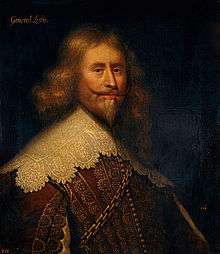
A Scottish army of 16,500 men under the experienced veteran Alexander Leslie, camped a few miles away on the other side of the border near Duns.[17] Both sides included large numbers of professional soldiers who had served in the European wars, but the senior English commands went to Charles' favourites, who were largely inexperienced.[18]
Charles joined his troops at Berwick on 30 May, announcing he would not invade Scotland, as long as the Covenanter army remained ten miles north of the border. Leslie advanced to Kelso, within the ten mile limit, but neither side was anxious to fight; on 11 June, negotiations began that ended in the Pacification of Berwick on 19 June. This agreed to refer all disputed questions would be referred to the General Assembly, or Parliament of Scotland, for resolution. However, both sides viewed this as a truce, and continued preparations for another military confrontation.[19]
The only significant engagement of the war took place on 18 June, at the Battle of the Brig of Dee south of Aberdeen, between Royalist forces under Viscount Aboyne and Montrose. It resulted in a Covenanter victory, although casualties were minimal.[20]
Interlude
.jpg)
The kirk's General Assembly met again in August 1639 and confirmed the decisions taken at Glasgow, which were then ratified by the Scottish Parliament. When Charles' representative, Lord Traquair, tried to suspend it, his action was declared illegal and Parliament continued to sit. A series of acts were passed which amounted to a constitutional revolution, including Tri-annual Parliaments, and making the Covenant compulsory for all holders of public office.[15]
His advisors convinced Charles the only way to finance a second war was to recall the English Parliament, and in December 1639, he issued writs for the first time since 1629. Thomas Wentworth, 1st Earl of Strafford, his most capable advisor and Lord Deputy of Ireland also asked the Parliament of Ireland for funds; in March, they approved an army of 9,000 to suppress the Covenanters, despite violent opposition from their co-religionists in Ulster. This is an example of how the Bishops Wars destabilised all three kingdoms.[21]
Charles hoped this would provide an example for the Short Parliament, which assembled in April; however, led by John Pym, Parliament demanded he address grievances like ship money before they would approve subsidies. After three weeks of stalemate. Charles dissolved Parliament; he would have to rely on his own resources to fund the war. Meanwhile, in January 1640 the Covenanter leaders mustered their regiments, and to secure their rear, occupied Aberdeen, centre of the Royalist north-east.[22]
1640: Second Bishops' War

In June, the Scottish Parliament met in Edinburgh, and granted Argyll a commission of 'fire and sword' against Royalist areas in Lochaber, Badenoch and Rannoch. A force of 5,000 conducted this campaign with great brutality, burning and looting across a large area, one of the most infamous acts being the destruction of Airlie Castle. By seizing Dumbarton Castle, they also prevented Strafford's Irish army from landing in Scotland, allowing them to focus on the threatened English invasion.[23]
The Scots assembled an army of 20,000 under Leslie's, well-equipped and with vastly superior artillery. The English troops consisted largely of militia levied in the south, poorly-equipped, unpaid, and unenthusiastic about the war. On the march north, lack of supplies meant they looted the areas they passed through, creating widespread disorder; several units murdered officers suspected of being Catholics, before deserting.[24]
Lord Conway, commander in the north, focused on reinforcing Berwick-upon-Tweed, the usual starting point for invading England. On 17 August, cavalry units under Montrose crossed the River Tweed, followed by the rest of Leslie's army. The Scots bypassed the town, and headed for Newcastle-on-Tyne, centre of the coal trade with London, and a valuable bargaining point.[25]
On 28 August, the Scots forced a passage over the River Tyne at the Battle of Newburn; they still had to take Newcastle, but to Leslie's surprise, when they arrived on 30 August, Conway had withdrawn to Durham. One suggestion is he did not trust his ill-disciplined and mutinous troops, but morale in the rest of the army now collapsed, forcing Charles to make peace.[26]
The only other significant action of the war was the siege of Edinburgh Castle, held for Charles by Sir Patrick Ruthven, who served with Leslie in the Swedish army. Blockaded since the end of May, starvation forced him to surrender in September.[27]
Aftermath
Under the October Treaty of Ripon, the Scots were paid £850 per day, and allowed to occupy Northumberland and County Durham pending final resolution of terms. It was widely believed these terms were agreed by the Scots in concert with the Parliamentary opposition, since funding this required the recall of Parliament in November 1640. The House quickly asserted its power by executing Strafford in May 1641; in August the Scots finally evacuated Northern England after the Treaty of London.[28]
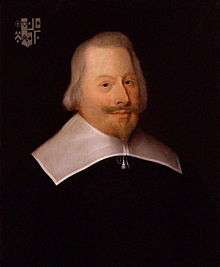
While defeat forced Charles to call a Parliament he could not get rid of, the 1641 Irish Rebellion was arguably more significant in the struggle that led to war in August 1642. While he and Parliament agreed on the need to suppress the revolt, neither trusted the other with control of the army raised to do so, and it was this tension that was the proximate cause of the First English Civil War.[29]
Victory confirmed Covenanter control of government and kirk, and Scottish policy now focused on securing these achievements. The 1643 Solemn League and Covenant was driven by concern over the implications for Scotland if Parliament were defeated; like Charles, the Covenanters sought political power through the creation of a unified church of Scotland and England, only one that was Presbyterian, rather than Episcopalian.[30]
However, ease of victory in the Bishops Wars meant they overestimated their military capacity and ability to enforce this objective.[31] Unlike Scotland, Presbyterians were a minority within the Church of England, while religious Independents opposed any state church, let alone one dictated by the Scots. One of the most prominent opponents was Oliver Cromwell, who claimed he would fight, rather than agree to such an outcome.[32]
Many of the political radicals known as the Levellers, and much of the New Model Army, belonged to Independent congregations; by 1646, the Scots and their English allies viewed them as a greater threat than Charles. Defeat in the 1648 Second English Civil War resulted in his execution; failure to restore his son in the 1651 Third English Civil War was followed by Scotland's incorporation into the Commonwealth, a union made on English terms.[33]
References
- Bannerman 1868b, pp260-295.
- Bannerman 1868a, pp433passim.
- Main.
- Harris 2014, pp. 53–54.
- Stephen 2010, pp. 55–58.
- McDonald 1998, pp. 75–76.
- Fissel 1994, pp. 269, 278.
- Wilson 2009, p. 787.
- Stevenson 1973, pp. 45–46.
- Mackie, Lenman & Parker 1986, p. 203.
- Mackie, Lenman & Parker 1986, p. 204.
- Plant.
- Mackie, Lenman & Parker 1986, pp. 205-206.
- Harris 2014, p. 372.
- Harris 2014, p. 374.
- Royle 2004, pp. 90-91.
- Royle 2004, p. 94.
- Gericke 2001, pp. 56-57.
- Pearce 2015, pp. 145-147.
- Royle 2004, pp. 91-93.
- Harris 2014, p. 380.
- Royle 2004, pp. 107-108.
- Royle 2004, p. 110.
- Royle 2004, p. 109.
- Royle 2004, p. 111.
- Harris 2014, pp. 345-346.
- Royle 2004, p. 108.
- Royle 2004, pp. 127–128.
- Harris 2014, pp. 347–348.
- Kaplan 1979, p. 207.
- Kaplan 1979, p. 208.
- Rees 2016, pp. 118–119.
- Royle 2004, pp. 609–611.
Sources
- Fissel, Mark (1994). The Bishops' Wars: Charles I's Campaigns against Scotland, 1638-1640. Cambridge University Press. ISBN 0521466865.
- Gericke, Bradley T (2001). Civil Wars in Britain; 1640-1646 (PDF) (PhD). U.S. Army Command and General Staff College.
- Harris, Tim (2014). Rebellion: Britain's First Stuart Kings, 1567-1642. OUP. ISBN 978-0199209002.CS1 maint: ref=harv (link)
- Kaplan, Lawrence (1979). "Charles I's Flight to the Scots". Albion: A Quarterly Journal Concerned with British Studies. 11 (3). JSTOR 4048612.
- Mackie, JD; Lenman, Bruce; Parker, Geoffrey (1986). A History of Scotland. Hippocrene Books. ISBN 978-0880290401.CS1 maint: ref=harv (link)
- Main, David. "The Origins of the Scottish Episcopal Church". St Ninians Castle Douglas. Retrieved 18 July 2020.
- McDonald, Alan (1998). The Jacobean Kirk, 1567–1625: Sovereignty, Polity and Liturgy. Routledge. ISBN 185928373X.
- Pearce, Dominic (2015). Henrietta Maria. Amberley. ISBN 978-1-4456-4555-1.CS1 maint: ref=harv (link)
- Plant, David. "Scottish National Covenant". BCW Project. Retrieved 25 November 2017.
- Rees, John (2016). The Leveller Revolution. Verso. ISBN 978-1784783907.CS1 maint: ref=harv (link)
- Royle, Trevor (2004). Civil War: The Wars of the Three Kingdoms 1638–1660 (2006 ed.). Abacus. ISBN 978-0-349-11564-1.CS1 maint: ref=harv (link)
- Stephen, Jeffrey (2010). "Scottish Nationalism and Stuart Unionism". Journal of British Studies. 49 (1, Scottish Special).
- Stevenson, David (1973). Scottish Revolution, 1637-44: Triumph of the Covenanters (2003 ed.). David & Charles. ISBN 0715363026.
- Wilson, Peter (2009). The Thirty Years War: Europe's Tragedy (2012 ed.). Belknap Press. ISBN 0674062310.
Bibliography
- Ballie, Robert (1841). The Letters and Journals of Robert Baillie (2019 ed.). Hardpress Publishing. ISBN 978-1318509577.
- Bannerman, James (1868a). The church of Christ : a treatise on the nature, powers, ordinances, discipline, and government of the Christian church. 1. Edinburgh: T. T. Clark.
- Bannerman, James (1868b). The church of Christ: a treatise on the nature, powers, ordinances, discipline, and government of the Christian church. 2. Edinburgh: T. T. Clark.
- Bruce, John, ed. (1858). Calendar of State Papers, Domestic Series, of the Reign of Charles I : 1625–1626. Longman, Brown, Green, Longmans, & Roberts.
- Donald, Peter (2004). An Uncounselled King: Charles I and the Scottish Troubles, 1637–1641. Cambridge University Press. ISBN 978-0-521-52007-2.CS1 maint: ref=harv (link)
- Lee, Maurice (1985). The road to revolution: Scotland under Charles I, 1625–37. University of Illinois Press. ISBN 978-0-252-01136-8.CS1 maint: ref=harv (link)
- Leslie, John (1830). A Relation of Proceedings Concerning the Affairs of the Kirk of Scotland: From August 1637 to July 1638. Ballantyne.CS1 maint: ref=harv (link)
- Gordon, James (1841). History of Scots Affairs, from 1637 to 1641 (2012 ed.). Ulan Press.CS1 maint: ref=harv (link)
- Johnston, Archibald (1841). Diary of Sir Archibald Johnston, Lord Wariston; The Preservation of the Honours of Scotland, 1651-52 (2017 ed.). Hansebooks. ISBN 978-3337008871.
- Macinnes, Allan I. (2003). Charles I and the Making of the Covenanting Movement, 1625–1641. Donald. ISBN 978-1-904607-03-8.
- McCoy, Florence N. (1974). Robert Baillie and the Second Scots Reformation. University of California Press. ISBN 978-0520023857.
- Russell, Conrad (1995). The Fall of the British Monarchies 1637–1642. Clarendon Press. ISBN 978-0-19-820588-3.CS1 maint: ref=harv (link)
